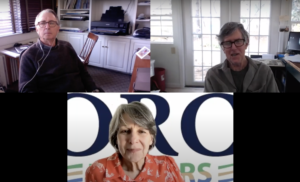Bringing the Bay Home: The Role of Photography and Writing in the Restoration Effort

Denice Wardrop, executive director of CRC, moderated the webinar with two expert speakers who provided inspiring perspectives on the role of photography and writing in the restoration efforts. Dave Harp, a photographer who currently has a virtual exhibit with Chesapeake Maritime Museum; and Tom Horton, a columnist for the Bay Journal and a professor at Salisbury University, spoke about the artistic inspiration of the water’s edge and how they translate what happens there to others through photography, cinematography, and writing.
Takeaways from the webinar
Dave Harp is a photographer that captures the diverse communities which inhabit the water’s edge. In his new virtual exhibit with the Chesapeake Maritime Museum titled Where Land & Water Meet, he portrays the connection between culture and nature through photographs and film that depict our lively waterways.
Tom Horton is an author that has written several books about the Chesapeake Bay. He wrote for The Baltimore Sun for 35 years and is currently writing a monthly column for the Bay Journal.
Dave and Tom have been collaborating on various projects concerning the Chesapeake Bay for the last 40 years. The combination of their photography and storytelling capabilities have provided us with a look into the heart of our local waterways. During the webinar, they provided behind-the-scenes thoughts and addressed current watershed issues.
- The effectiveness of restoration efforts can often be assessed by the measure of peaceful coexistence that we have achieved among the miles of edges with the rest of nature. Peaceful coexistence often requires us to make sacrifices and re-evaluate our lifestyles.
- Our visual and emotional attention is often drawn to the edge. This idea is supported by the fact that around half of the population lives on 5% of the Earth that is near the edges of coastal and lake systems.
- The watershed connects us and our actions to distant areas due to water’s ability to freely flow through divides. In addition to the watershed, the sky itself allows for the Chesapeake Bay to be woven into far away ecosystems as a result of migratory patterns. Animal species travel from Alaska to the Ungava Peninsula to the tropics to the Bay of Fundy, enriching the concept of watershed and connecting us to the rest of the world. Dave has begun to utilize drone equipment to capture these migratory phenomenons.
- Majestic occurrences, like the cloaking of the marsh elder (or miracle bush, Iva frutescens) by monarch butterflies at Smith’s Island and clouds of tree swallows descending from the fog in the upper Choptank, make the watershed a surprising and special place (see links to these articles, below). However, these events are ephemeral and unpredictable – the swallows and butterflies may not be in the same spot the next year – and highlight the special coupling of organisms and conditions.
- The magic of the Chesapeake Bay also comes from the human communities that inhabit the edge. The islander’s of Smith’s Island are deeply invested in the history of their land and have continued the crabbing techniques of their ancestors. According to them, the prettiest way to crab is scraping.
- It is challenging sometimes to be an environmentalist due to eco-anxiety, but Tom and Dave actively try to capture a mixture of both the good and bad. However, that can lead to romanticizing aspects of the edge including the lives of watermen. They acknowledge the dangers of glorifying actions like oyster harvesting considering there is only ~1% of the wild oyster population left.
- During the Q&A portion, Tom affirmed that there was some distaste regarding his recent article titled The case for a Chesapeake ‘style’ Bay that suggests reimagining restoration and re-evaluating our standards. This involves abandoning the unrealistic goal of achieving picture perfect restoration. Nevertheless, he is thrilled that the article provoked the beginning of a tough conversation.
- Currently, Dave and Tom are working on two films. One focuses on a farm near Hurlock that has re-engined the meat farming process to be Bay friendly. The other looks at why oysters have been such a hot topic for about 180 years.
A fitting quote for the intent of Dave and Tom’s work is this, from an article on one of their inspirations, Wendell Barry:
“The deal we are being offered appears to be that we can change the world without changing ourselves.”
Dave and Tom’s work does exactly that: gives us a place to change ourselves.
Resources for further action
Tom and Dave’s films are available for free through the Bay Journal
Dave Harp’s exhibit at Chesapeake Maritime Museum titled Where Land & Water Meet
Some of Tom’s columns discussed during the webinar:
